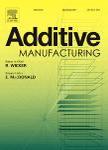版权所有:内蒙古大学图书馆 技术提供:维普资讯• 智图
内蒙古自治区呼和浩特市赛罕区大学西街235号 邮编: 010021

作者机构:US Air Force Res Lab Mat & Mfg Directorate Wright Patterson AFB OH 45433 USA UES Inc Beavercreek OH 45432 USA Ohio State Univ Dept Integrated Syst Engn Columbus OH 43210 USA
出 版 物:《ADDITIVE MANUFACTURING》 (Addit. Manuf.)
年 卷 期:2019年第25卷
页 面:485-498页
核心收录:
学科分类:08[工学] 0805[工学-材料科学与工程(可授工学、理学学位)] 0802[工学-机械工程]
基 金:We wish to acknowledge Jonathan Miller at the Air Force Research Laboratory for many helpful conversations. Thomas Spears of GE Aviation and Joy Gockel of Wright State University were instrumental in executing single track deposition experiments and Sonya Boone of UES collected images of multi-track deposits
主 题:Selective laser melting Powder bed fusion Thermal modeling Model verification and validation
摘 要:Significant attention has been focused on modeling of metallic additive manufacturing (AM) processes, with the initial aim of predicting local thermal history, and ultimately structure and properties. Existing models range greatly in physical complexity and computational cost, and the implications of various simplifying assumption often go unassessed. In the present work, we first formulate a fast acting Discrete Source Model (DSM) capable of handling the complex processing often encountered in metal powder bed fusion AM. We then assess implications of the source representation, details of the numeric implementation, as well as effects of boundary conditions and thermophysical parameters. We verify the DSM implementation against simple numerical thermal predictions, calibrate it with single track deposit experiments, validate outputs against multitrack deposits, and finally quantify the scaling performance. The DSM is an effective means of quickly generating an estimate of the local thermal history induced by complex scan strategies when combined with arbitrary component geometry. While a number of approximations limit its quantitative accuracy, the inexpensive nature and ability to treat complex processing plans suggests it will be useful for screening and identification of regions experiencing anomalous thermal history. Such a capability is necessary to direct usage of higher fidelity, more expensive models and experimental resources.